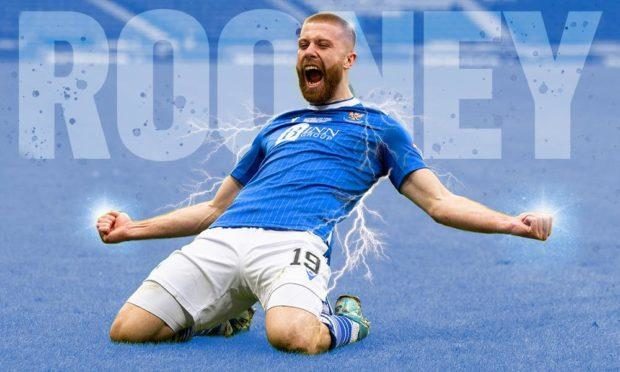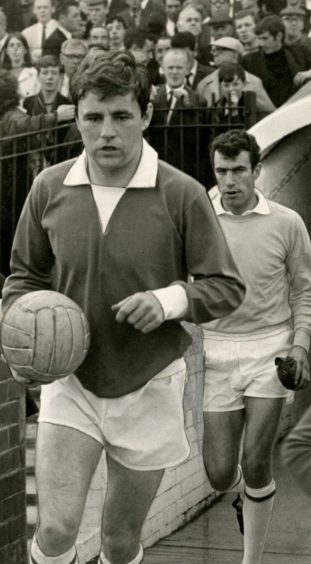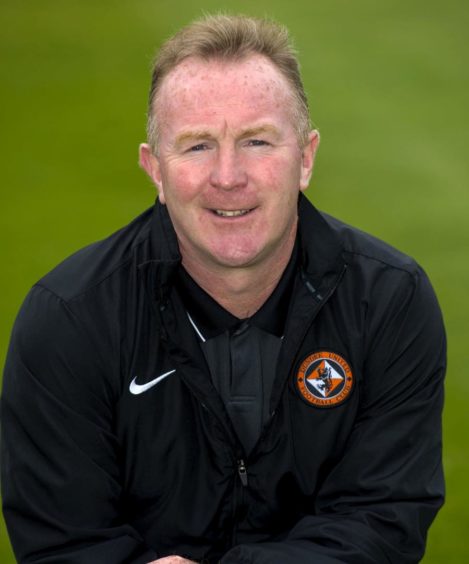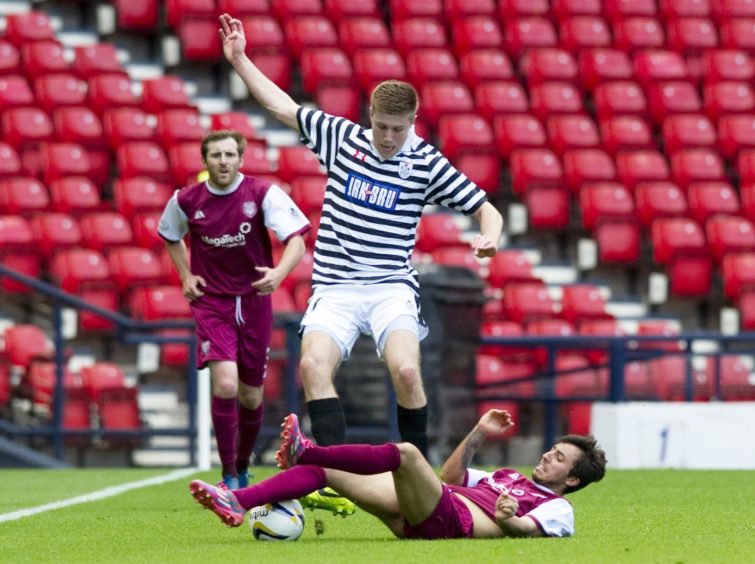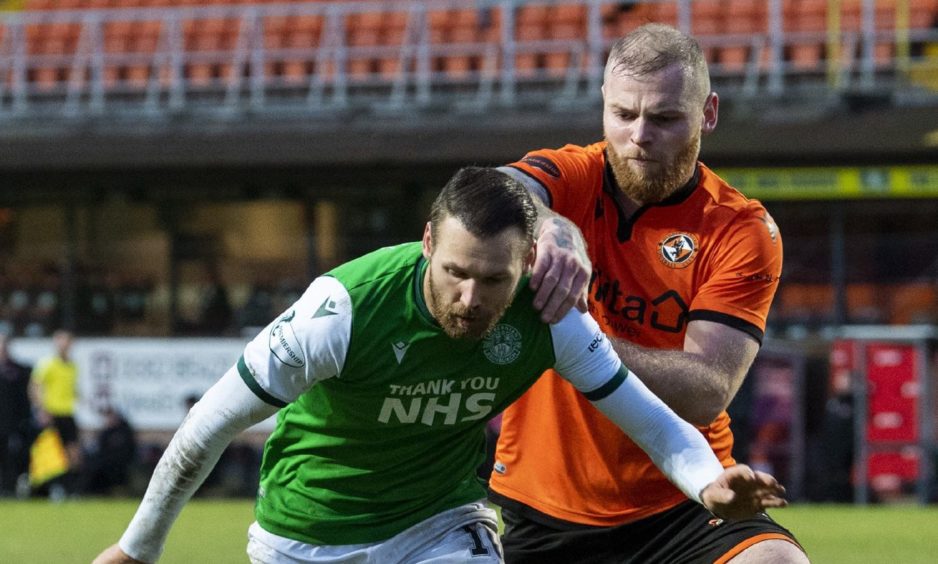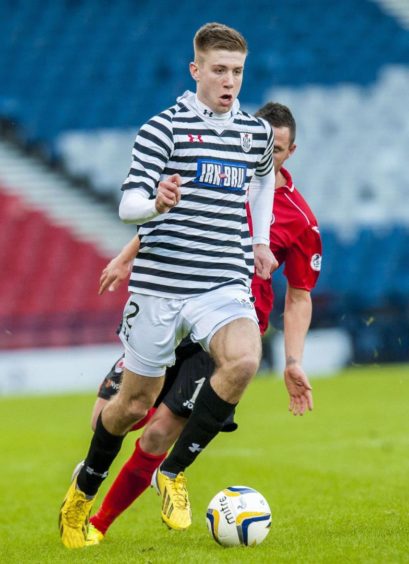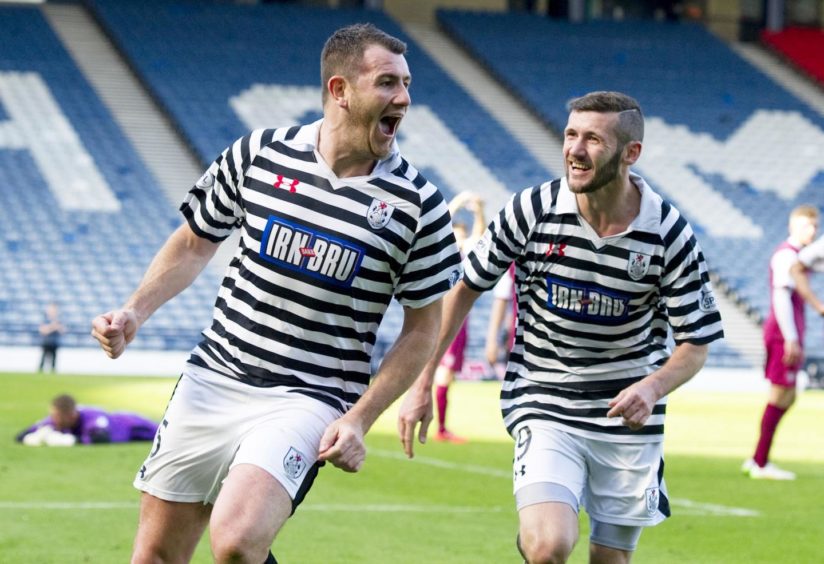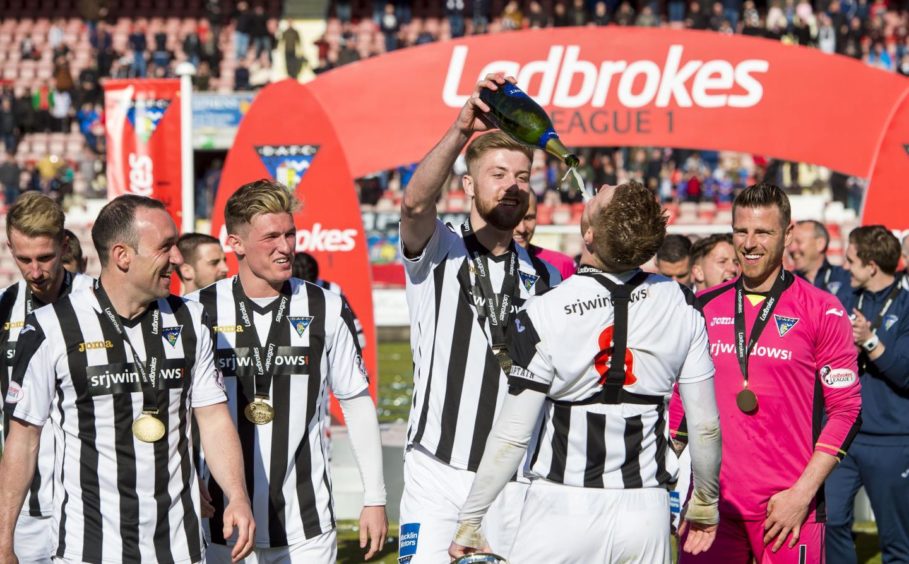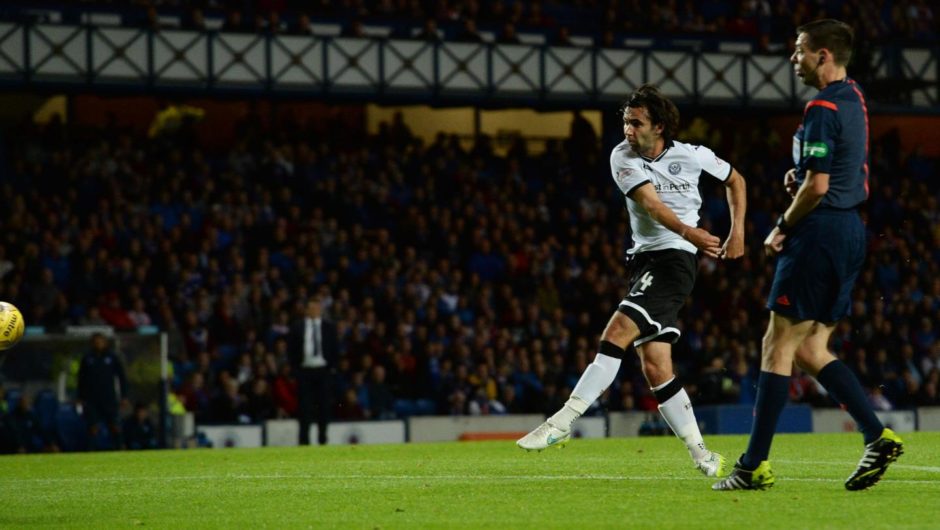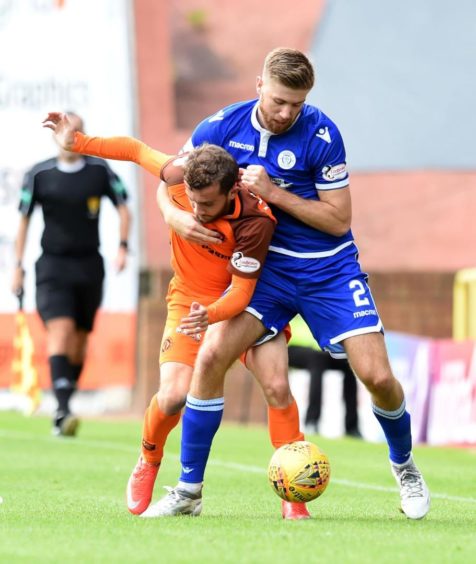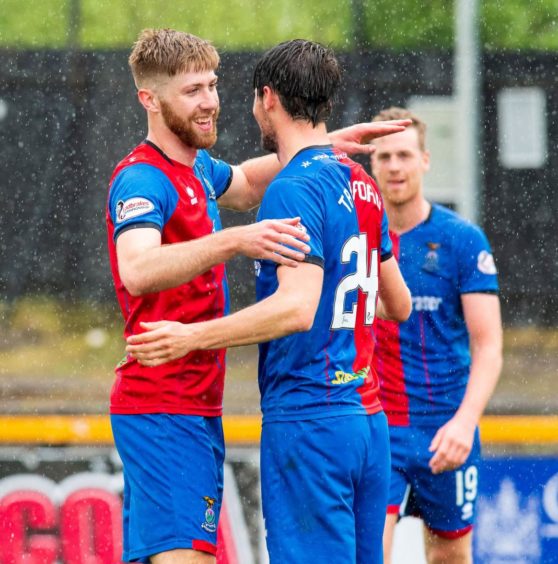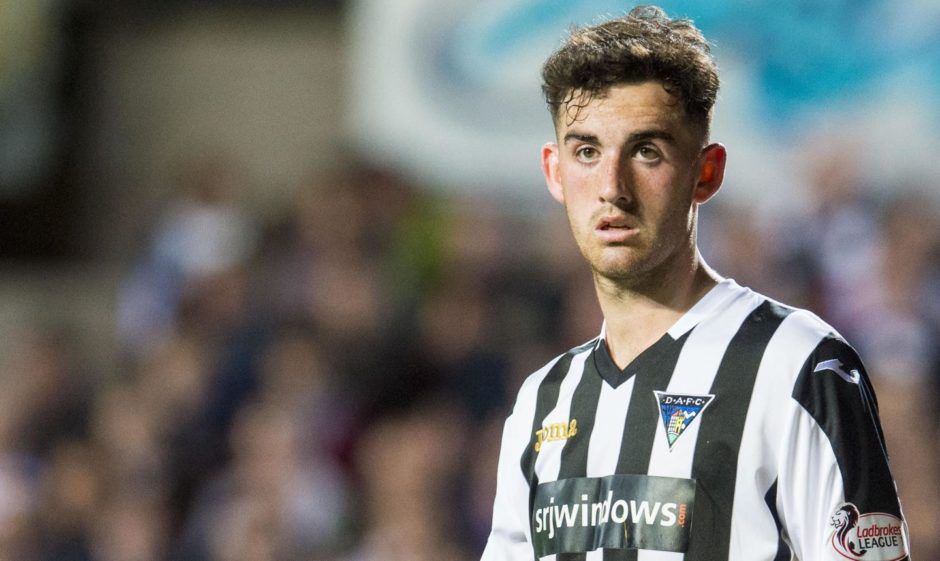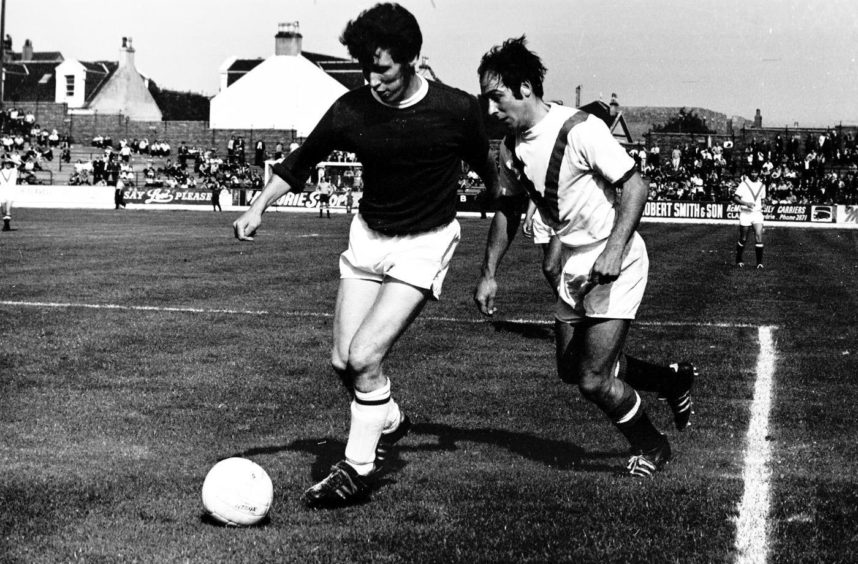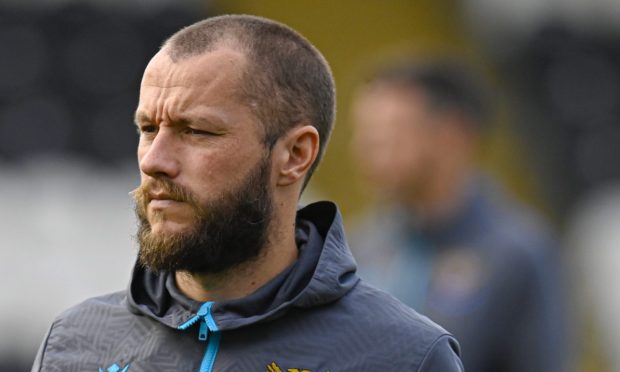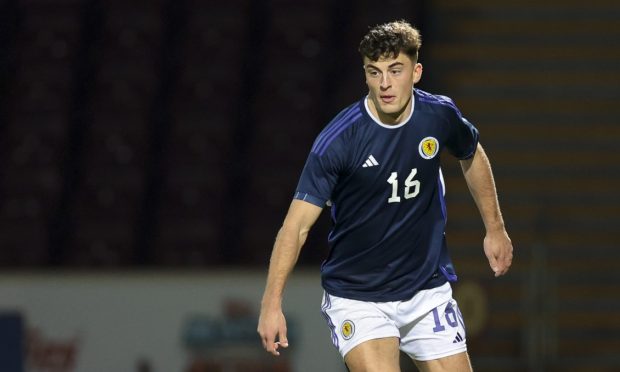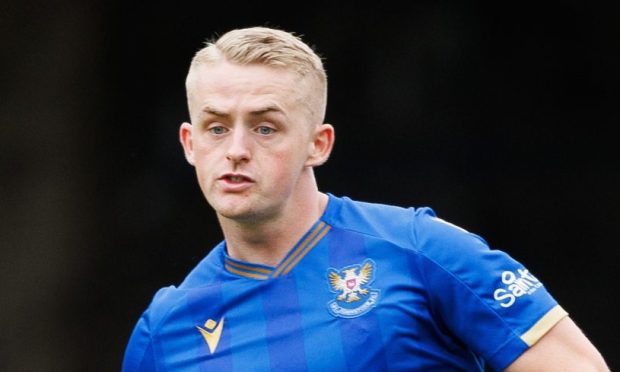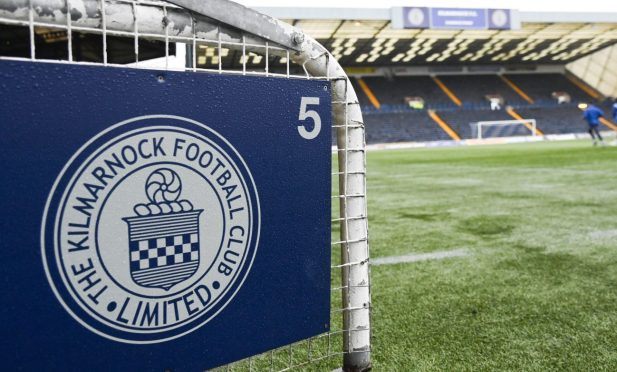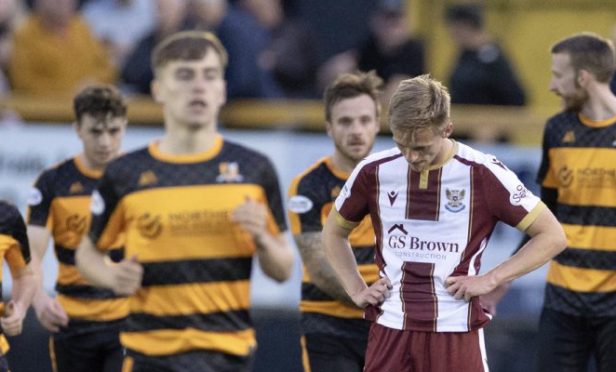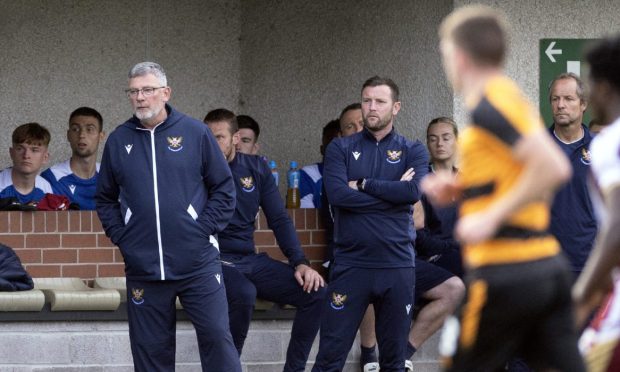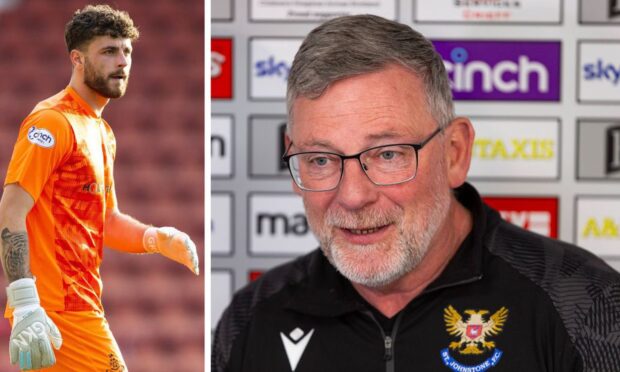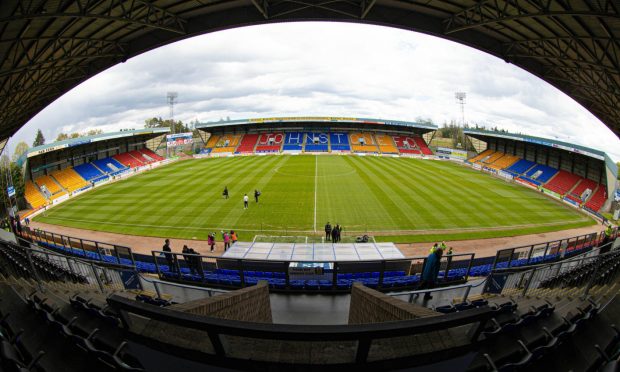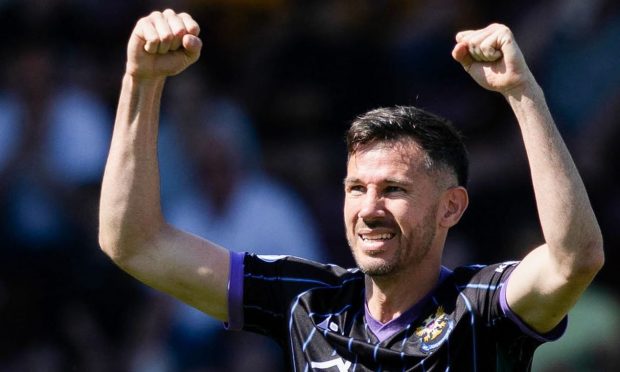Dementia will have robbed Benny Rooney of so many precious life memories and cornerstones.
But blessedly, an appreciation of his place in St Johnstone history endures.
Hopefully, so too will the pleasure he absorbs through watching the elevation of a family member to exalted status with the club closest to his heart. It’s a place among the legends he earned for himself.
The one to 11 of Saints’ famous 1969 League Cup final team can be rattled off by Rooney, the fearless centre-half who was their captain, quicker than a John Connolly drop of the shoulder and daring dash.
And moving the conversation forward to the subject of the match winner the next time Saints were back at Hampden Park for a final brings a similarly instant sparkle to his eyes.
There’s a wonderful footballing symmetry to Benny Rooney breaking new ground by leading his side onto the turf of the national stadium for the first time in a final and Shaun Rooney breaking new ground by being the goal scoring hero when the trophy was eventually secured on the same pitch 52 years later.
“It was a header I’d have been very happy with,” said Benny of great-nephew Shaun’s iconic front post finish from Craig Conway’s corner in the 1-0 Betfred Cup victory against Livingston. “Very much so.
“I scored quite a few with my head – more with my head than my feet. It was a forte of mine so it must run in the family!
“It’s only after the game that I realised how terrific it was for this to have happened all these years later after our cup final. It’s something for the family to be very proud of. It was lovely that Shaun mentioned the connection after he won the cup.”
💪 @StJohnstone v @LiviFCOfficial
🏆 Scottish Premiership
🏟 McDiarmid Park
🗓 Today
🕰 12:30 kick-offShaun Rooney got the winner in the #BetfredCup final, who can get the goals today?
Get all the Stats & Numbers in our Stat Centre – https://t.co/1UhTAYB8UO #SPFL #STJLIV pic.twitter.com/F9lhD8Rx2T
— SPFL (@spfl) May 15, 2021
Football in the family
As older Saints supporters will recall, Benny came close to claiming the accolade of the first Perth player to score in a Hampden final.
In search of an equaliser against Jock Stein’s Celtic, who were clinging onto their 1-0 lead, he produced a defence-into-attack burst forward of the type that has become a familiar sight when the wide open spaces of Mount Florida have opened up for Shaun in three big games in one calendar year.
“I came from the back, went on a crazy run, finished up at outside right and came along the byeline, hit it, but it didn’t go in,” said Benny.
The deeper you look, the more you find sporting threads that link two men of one family.
Benny started out as a striker. So too did Shaun.
“I was a centre forward right through until I was at St Johnstone,” said the man who is number 28 in a book ranking the all-time top 50 players. “There was an injury, I went back to centre-half and he (manager Bobby Brown) just kept me there.
“I think it makes you a better defender if you’ve played up front – it certainly did for me. You can visualise what runs the forwards will make. That’s the case whether you become a full-back like Shaun or a centre-half like me.”
Benny played in Dundee United colours. So too did Shaun.
For the latter it was never to be in the first team.
Rooney’s early days at Dundee United
The former United head of youth who now puts Shaun in his top three ‘ones who got away’ (he’s in very good company) believes moving on from Tannadice was the making of him.
Recalling the 24-year-old’s path into professional football, Stevie Campbell said: “Graeme Liveston (United’s then chief scout) had a lot of connections in the west.
“That helped get us the likes of Scotty Allan and Johnny Russell.
“Graeme moved on and Brian Grant came in around 2008/2009. Brian came in to the club to more or less fill Graeme’s position. Shaun was in our system as it were and we brought him in from Bellshill.
“The biggest thing I remember about him was his athleticism. And he had such a great attitude as well.
“I’ll never forget a game he played for us against Hearts at Tynecastle. It was near the end of the season and we had a lot of games to catch up on.
“I put Shaun up front and he scored the winner. It was a brilliant game and a fantastic header. As we can all see now – he’s certainly still got that presence in the box.
“He was fearless then and still is.
“Things were going really well.
“I can remember Brian telling me that Shaun hadn’t been offered an unconditional contract but we wanted him to come in for pre-season for six weeks. We thought it would be a formality that he would get a deal at the end of it.
“It was a case of ‘come in and prove your worth’.
“Shaun and his dad – and there’s nothing wrong with this – turned it down. That’s my recollection of it.”
Campbell watched a lot of live football back in those days, with many games blurring into one. His next sighting of Rooney sticks in the memory though.
“Fast forward a couple of years and I was at Hampden for Queen’s Park against Arbroath after having a youth game in the morning,” he said. “I would have been watching Simon Murray and Marc McCallum. I think it was the play-offs.
“By this point Shaun was the big marauding right-back we know now.
“He was excellent that day. I can remember speaking to his dad who said that we should have signed him. That certainly didn’t bother me.
“There are different routes for different players and, looking back, it was the best thing that ever happened to Shaun.
“If you’re the right type of person, these wee knocks are the perfect motivation. I can guarantee you it will have given him motivation to prove Dundee United wrong.
“We all know Andy Robertson’s Celtic story and Stuart Armstrong’s at Aberdeen.
“United didn’t sign him but somebody else did and he’s taken his opportunities since then. It’s been the making of Shaun and I couldn’t be happier for him.
“Even back then I would have said that right-back would end up being his best position.
“He has always been a player who has caught the eye because of his size and the amount of over-lapping he can do.
“As the years have gone on his know-how about defending has improved. But his goal threat will never change, whether it’s getting in at the back post or from set-pieces.
“I’ve never got too hung up on positions.
“In my early days I moved Scott Robertson from being a right-winger. Paul Dixon, believe it or not, was a midfielder and I ended up playing him at left-back.
“Craig Levein was throwing Lee Wilkie up front in the first team and I was doing the same with Shaun Rooney!”
You’ll find plenty of youth coaches who either attempt to rewrite history or want to put a pen through it if a player they allowed to move on flourishes under another club’s watch. Not Campbell. He sees the bigger picture – and the individual one.
“That will never be me,” he said.
“I’m not saying I was the only one involved in the decision but I would have been instrumental in it with Brian. At that point it was only our opinion.
“Every player who moves on, you tell them that you hope they prove you wrong. And, for me, it’s not a lie.
“Jack Hendry is one who didn’t make the next step for whatever reason. He was in with me at United.
“It’s the same with Martin Boyle. You can bring Martin into that conversation. Not many people know about him.
“Nobody wants to write a long list of the ones who got away but you certainly do get circumstances that can lead to it happening.
“For me as a youth coach who has to make decisions there is nothing better than seeing somebody who didn’t get the opportunity at the club you worked at going on and having a career. That’s what you want to see.
“There’s three who, if I’m being honest, you do look back and think ‘what might have been’ but it doesn’t stop you thinking how brilliant it is that they’ve succeeded.
“Shaun has shown his mettle and long may it continue.
“You want players you’ve worked with to be a success. Obviously not all of them will do it but when one does progress I’m absolutely delighted to see it. Let’s hope he progresses even further.”
A timely move to Queen’s Park
Whether Rooney already knew he would be taken on by Queen’s Park when he told United ‘thanks, but no thanks’ matters not. That he chose the right place to get a fast track to men’s football is inarguable.
As he was arriving in the summer of 2013, Andy Robertson was heading in the opposite direction. This was a club which had found its point of difference – putting the first layer of polish on a rough diamond.
Captain Tony Quinn saw all the good ones come and go but even in that context, Rooney’s instant impact stands out.
“My first memory is the manager, Gardner Speirs, bringing him in with the first team for pre-season when he was only 16,” said Quinn.
“On the first night he just ran and ran. It was unbelievable. All the boys were saying: ‘Who the hell is this?’ He’d run all day.
“So you get talking to him and he tells you how old he is. A couple of the experienced ones, myself included, would have had a wee word after a couple of nights to tell him not to keep showing us up in training!
“It’s not easy for a boy of his age to come into a dressing room of senior pros but he got straight involved with the banter in the changing room and everybody took to him right away.
“As everybody knows, there were a lot of good young boys who came through at Queen’s Park but it was usually at 17 or 18. Not 16.
“We didn’t know what position to play him in at first. He played with me in central midfield at one point. It was in a game early on in the (2013-14) season when we lost 6-0 at Raith. I remember Joe Cardle having a great game. But Shaun was the type of boy who would have just dusted himself off and got ready for the next one after a defeat like that. There were a few at that time.
“He ended up in the right wing-back role and he was excellent – especially at Hampden. That long throw of his was more use at the tight grounds than Hampden, mind you.
“He was just a big gazelle. He opened up those long legs and away he went. He’s got technically better over the years which comes with playing games and moving up the levels.”
Quinn can remember the Rooney clan congregating at Hampden and Benny was sometimes among them. The Queen’s Park connection was, and still is, a strong one.
“When Shaun was with us he worked in a factory, I’m sure, but the club were trying to get him a job at Hampden like Andy Robertson,” said Quinn. “But from memory, I’m sure transport was a problem. He had to wait until his dad finished work to bring him in for training from Bellshill.
“We’re all still in a group chat from that squad,” said Quinn. “Before lockdown his dad was coming to Queen’s Park games when he got the chance.
“We’re all delighted to see Shaun doing so well and he’s got a chance of going even higher. Mind you, he’ll be in no rush to leave because St Johnstone are flying under Callum Davidson.
“I’d like to think the likes of Shaun and wee Andy have listened to some things along the way.
“Andy has had an exceptional career. It’s unbelievable to think he’s won the Premier League, Champions League and is the Scotland captain from where he’s come from. There was nothing more pleasing than seeing wee Andy lift the European Cup.
“Barry Douglas, Paul McGinn, Lawrence Shankland and Paul Paton are others who have gone on to do very well. There have been a good few over the years. Queen’s Park should be proud for giving them their chance.”
According to Quinn, Speirs’ successor Gus McPherson got more out of Rooney in his second and last season with Queen’s Park. The numbers – 30 appearances compared to 11 – back that up.
As does the fact the team narrowly missed out on promotion out of the bottom division through the play-offs and he was voted into the PFA best 11 by his fellow professionals.
Hearts showed an interest, and took him on trial. So too St Mirren. But his return to full-time football came in League One with Dunfermline. A step-up in level but not much of an advancement in his career as it turned out.
The Pars won the title but Rooney was a peripheral rather than pivotal figure. Manager-player trust between he and Allan Johnston was never cemented.
Pars midfielder Shaun Byrne, now with Dundee, said: “It’s a big difference going from part-time to full-time and it can take a while to adapt.
“I remember Ryan Williamson started at right-back that season and even when he got injured, Lewis Martin played there and they brought in another right-back, Craig Reid. Andy Geggan could fill in at right-back as well. Shaun was third or even fourth choice sometimes.
“That probably showed that he (Johnston) didn’t fancy Rooney as much as others. Getting that later in his career has been the making of him. By the time I played against him at Inverness his career started to take off.
“He was a different player. He’d cut out the stupid bookings and moaning at referees.
“He’s gone from not being a regular in League One to scoring the winner in a cup final and being linked with Scotland. It shows you what someone putting faith in you can do. Confidence is such a big thing for a footballer.”
It’s ironic that the manager who was in charge of the Dundee United first team when Rooney left there was the same man who signed him after a season of drift at East End Park, Jackie McNamara.
York Calling
By now the chief executive at York City, McNamara recruited a 20-year-old Rooney to try and get the club back into the Football League after the relegation ordeal of the previous season and everything that had gone with it.
Frying pans and fires spring to mind.
Simon Lappin joined Rooney at York but this was a club yet to reach its rock bottom. If soaking up some more life lessons and football hard knocks was the aim, this was the place for it.
“I signed October/November time,” said Lappin. “York had just fallen into the National League and Jackie wasn’t the manager anymore. He’d brought in a lot of younger lads.
“We were slipping down the table and things were going from bad to worse.
“I don’t care what level of football it is, that’s a difficult situation for a boy trying to start out in the game. They need older ones around them.
“I was only there for about seven or eight months.
“Shaun was in and out of the team. There was no doubting his engine or his enthusiasm but he was still learning the game and how to deal with certain situations.”
The York City correspondent for the local newspaper certainly thought so, marking Rooney four out of 10 for his year’s work.
“Needs to work on his game intelligence to progress in the game,” and “Difficult to trust him in a game situation” were among the observations.
“A season like that can make or break you,” Lappin added.
“It’s all about what you take from these experiences. Sometimes it’s good for you to have them. You think: ‘I’m not going to let that happen again’.
“When it came to training you could see he was an athlete but I wasn’t so sure about him with the ball or his positional sense. Remember, though, he was still so young.
“He had the ability to move on from a bad game, which is a good quality to have as a footballer. Not just a footballer, actually, in any walk of life.
“People are so quick to criticise.
“I’m sure he would analyse and reflect on his performance but not letting it affect you is a good thing. You need to learn to let it go. There’s nothing you can do about the poor performances.
“Shaun seems the type of guy who doesn’t have to worry about that – he just bounces from day to day and nothing fazes him too much.”
By the sound of things there might have been a few occasions when bouncing from one good night to another was part of the Rooney York lifestyle as well.
“When I arrived there were a few Scottish lads,” said Lappin. “I think Shaun shared a flat with Aidan Connolly and a couple of others.
“I’ve no idea what they got up to during the day – or night – but they were certainly a lively group. It always seems to be the Scottish ones who are the life and soul of the dressing room.
“Shaun was daft as brush. He was one of those characters who, if you told him to do something, he would do it. He had so much carry-on in him.
“It was all good fun. There was never any harm or malice. Most dressing rooms have one – and more often than not, it’s a Scot!
“Maybe he wasn’t taking his football as seriously as he is now.
“We’ve all been teenagers at one point. Shaun was away from home. He probably just wanted to have a good time. York is a good night out – I enjoyed it myself a few times. Never with Shaun, I might add!
“Hats off to him. He’s worked at his game, got his opportunity at St Johnstone, bided his time there and look at what he’s done now. I’m really pleased for him.
“You’ll never change his character but he’s older now and he realises the opportunity he’s got. He’ll know the work he has to put in and when it’s the right time to enjoy himself.”
Queens move a catalyst to greater things
When York decided to cut short Rooney’s two-year contract and Gary Naysmith was made aware of his availability, it was the player he recalled from Queen’s Park rather than the one who lost his way in Fife and the north of England he was hoping to get the best out of half-way inbetween at Dumfries.
“I remembered him playing for Queen’s Park against us when I was at East Fife, constantly getting up and down the wing,” said Naysmith, manager of a Queen of the South side becoming more accustomed to life near the top of the Championship than the bottom.
“We were looking for a right-back that summer and Shaun had stuck in my head. I think I was on holiday when I phoned him.”
With team-mates of the quality of Stephen Dobbie, Lyndon Dykes, James McFadden, John Rankin and Jason Kerr, this was the highest calibre side he had been tasked with establishing himself in.
By the time his one year was up, Rooney the footballer was getting closer to the one Saints fans have afforded hero status to. But the big ‘living the life’ leap forward had yet to be made.
“When he came to us he kept giving fouls away near our box for pushing people and didn’t seem to learn,” said Naysmith.
Nine yellow cards in 34 games backs up his recollection.
“The penny has obviously dropped since because he wouldn’t be playing at the level he is if he was still making those bad decisions.
“Most of those bookings were silly ones. He was too eager to try and get the ball rather than standing up and making himself hard to beat. He end up pushing them or going through the back of them.
“We actually started playing him on the right side of a three after he had signed a pre-contract with Inverness and he was outstanding.
“We had Scott Mercer at the time as well – the two of them were eeksy peeksy.
“He didn’t play as often as he would probably have liked but it was only at the end we discovered how good he could be as a right-sided centre-back in a three. And by then he’d signed a pre-contract with Inverness.
“His natural instinct is to drive forward as everybody can see. That’s his biggest asset. There aren’t many right-backs with his athleticism who get forward like he does.
“He signed his pre-contract with Inverness quite early so we never got the chance to have a proper chat about the next season.
“I think what caught their eye was the outstanding first half he had in a game against them up there.”
If you want your body to perform at its maximum you have to refuel it properly. It’s that simple.
Naysmith added: “I just knew that he had to improve his all-round attitude really – how he looked after himself from football.
“It wasn’t as if had a nutritionist or anything like that at Queen of the South who could help him.
“He’s had to learn through experience that to get the best of yourself on the pitch you have to get the best out of yourself off the pitch.
“It’s not rocket science. If you want your body to perform at its maximum you have to fuel it properly. It’s that simple.
“The ability was always there and he’s a lovely boy but natural talent isn’t enough to get you to where you want to go as a footballer. There are other factors. Shaun has learned that.
“It doesn’t stop, though. If you let things go to your head or let your standards slip, things can soon change again. He’s on track now at St Johnstone and if keeps performing well and progressing other clubs will be looking at him.”
Moving on up north
If Rooney’s York and Bellshill domestic circumstances proved to be more conducive to a thriving social life than a thriving football career, he found a better – and arguably defining – balance in a sleepier part of the British Isles: Inverness.
Right place, right time and right peers.
One of those peers, Charlie Trafford, picks up the story.
“It wouldn’t be right to say when he came up he was still a boy but he was a little bit all over the place,” said the Canadian, now at Hamilton Accies.
“We had a great group. Even in normal times down here (the central belt of Scotland) you don’t spend a lot of time with your team-mates because everyone has their family and friends.
“But up there because you are so isolated and there are very few boys who are actually from Inverness, there was a group of us who spent so much time together – guys like James Vincent, Jamie McCart and Sean Welsh.
“They were very good professionals and we ended up spending a lot of time in the gym.
“You could see Rooney’s diet change and different stuff like that.
“He had so much going for him in terms of his genes and his ability and you could see him growing as time went on. Everything needed to click. Being part of another good group at St Johnstone will help again.
“He lived with Jamie (McCart). It wouldn’t surprise you that Jamie was the sensible one! But I’ve got nothing but great things to say about Shaun as a character.
Thanks to @JamieMcCart123 and Shaun Rooney for giving up their time tonight to answer questions and present the awards to the Inverness Street League teams and thanks to @ICTFC for the use of the suite tonight. @joshanderson_99 pic.twitter.com/uUdCYHGwVA
— Drew Anderson (@mrdrewanderson) October 10, 2018
“Sometimes you get lucky. It was the perfect group for him – and the rest of us. We all benefitted. I took a big pride in going to the gym and how I was eating. Jamie had an academy background at Celtic and he came from a sporting family. So he was a great professional.
“Had it been boys who liked a good drink and had the wrong attitude it could have been a different story. It was just one of those environments that became really positive and allowed us to push each other on.
“I don’t know what Shaun’s background was like at home but there’s a totally different lifestyle needed from a footballer to someone working a nine to five job.
“They’re not worried about their diet. You can get sucked into that sort of environment and end up drinking a bit more.
“To be geographically isolated has an impact.
“The people close to you have so much influence. You can get lucky or unlucky.
“It could have gone the other way. We got lucky it was that group. In those same circumstances with a different attitude it becomes a totally different story. We liked to be around each other and we did the right things.
“When you reflect on your career you look back at those type of moments.
“There were seven or eight of us in that team who signed up the way so that can’t be a coincidence. In the end for Shaun, and others, it all clicked.”
Dark days
It was a cruel irony that as all the football pieces were coming together in the Highlands, they were being scattered back home. Within the space of a few months, Rooney lost his mother and grandfather.
“He’s had tough times,” said Trafford. “Personal traumas.
“He pushed it inside a bit. None of us can know what is the right way to deal with something like that. How can you?
“All the boys were there for him for sure. He would go up and down that road and he knew he just needed to get on with it. Football was maybe a distraction for him – the same with being around the boys.
“He uses it as motivation now and it helps him focus. All the credit to him for keeping going and advancing his career as he has.
“I would have spent a lot more time with him this year now that we’re living in the same part of the country. It’s been a big frustration of Covid that I haven’t been able to. It would have been brilliant.”
There is one of Rooney’s former team-mates who has ingrained empathy for the mental challenges he will face in tackling life without a parent or parents.
It is a measure of Shaun Byrne as a young man, and of the bond footballers form even if their time playing together is fleeting, that he showed compassion during a dark period.
“We’ve had conversations,” said Byrne. “I messaged him on Instagram and we spoke from there.
“It was something I wanted to do. It’s important to help people through times like that but it’s important you look after yourself too.
“When my mum passed away I just missed one day’s training and got straight back into it. Football was my release from all my problems at home. It took away all the pain for a while.
https://www.instagram.com/p/CCynE2SpuYT/
“You do want to make your mum proud. It was emotional for me when I got promotion with Livingston. When the final whistle went, there was the feeling of achieving something and my mum and dad looking down on me.
“You can see from his goal celebrations, he’s like me, wanting to make his mum proud. He’s said that he wants to make his mum proud and she definitely will be.”
There would be maternal pride in the goals her boy scored to help St Johnstone win only the second national trophy in their history. And also in the resilience and dedication he has shown in his relatively short period in Perth.
Liam Craig knows a crossroads moment when he sees one.
For Rooney that came in the contemplative shade of the main stand at Kilmarnock after a mistake in the Ayrshire summer sun on his full Premiership debut gifted the opposition a goal and brought about his 65th minute withdrawal.
“Shaun had a very tough time that day,” said the man closing in on the all-time Saints appearance record. “But it was a new team for him and a new position.
“When he wasn’t playing he was going to the coaches and sports scientist to see what he could do to make his game better.
“That was where Macca (Steven MacLean), Eck (Alex Cleland) and the manager (Callum Davidson) have been brilliant. You can’t underestimate how important their man-management skills have been for Shaun.
“They’ve shown their belief and confidence in him. Look at that Kilmarnock game – he wasn’t hung out to dry.
“As a football player all you want is to have people believe in you.
“As much as he’s a big dafty off the pitch he’s very serious on it.
“You’ve got a player who wants to work on his weaknesses and you’ve got a management team willing to put in the hours to do it by spending time on the training pitch and on videos to improve him positionally, when to go, when not to go. That’s what he’s got here.
“He probably thought he would come into the team straight away but Danny McNamara was exceptional and Shaun would have realised that he needed to be better to play at this level week in, week out.
“It could have gone either way but one thing you need as a footballer is resilience.
“Yes, you can have a bad game or a bad training session but you have to put it behind you and be thick-skinned. It’s something I tell our young players now.
“Shaun is a prime example of reacting positively. He will jump on you in training if something happens. But he’ll do it in the right way. We all look after each other.
“And on the park his game has gone from strength to strength. Talk about big goals – he scored in the quarter-final, semi-final and final. He’ll do well to top that in his career.”
New legacies
Blood connections and even a Hampden winner are all well and good but Benny Rooney sets the bar high when it comes to St Johnstone right-backs – both in terms of what they bring to a team on the pitch and off it.
The modern-day McDiarmid maverick is emulating the original, and the best from the Muirton Park era, John Lambie.
Benny can give no bigger compliment.
“John was a very good full-back,” he said. “And he let us know it as well!
“He was a real character and was ahead of his time in the sense of the amount of attacking he did.
“It wasn’t common in those days. To be honest I used to shout him back a lot. He had this knack of going at the right time. That was something new for us.
“It’s a very big weapon for a team to have, especially the way football is played just now. The winger can drop inside and the full-back can just go outside him. Shaun can do that very well.”
A few years have passed since Benny has seen St Johnstone or Shaun play.
Killing two birds with one stone at McDiarmid next season in the company of the ’69 buddies he used to share the quarter-past-seven train from Glasgow to Perth with each working day would beautifully book-end this family story.
“That would be a real privilege,” said Benny. “And maybe it could be two winners’ medals Shaun has to show me!”
